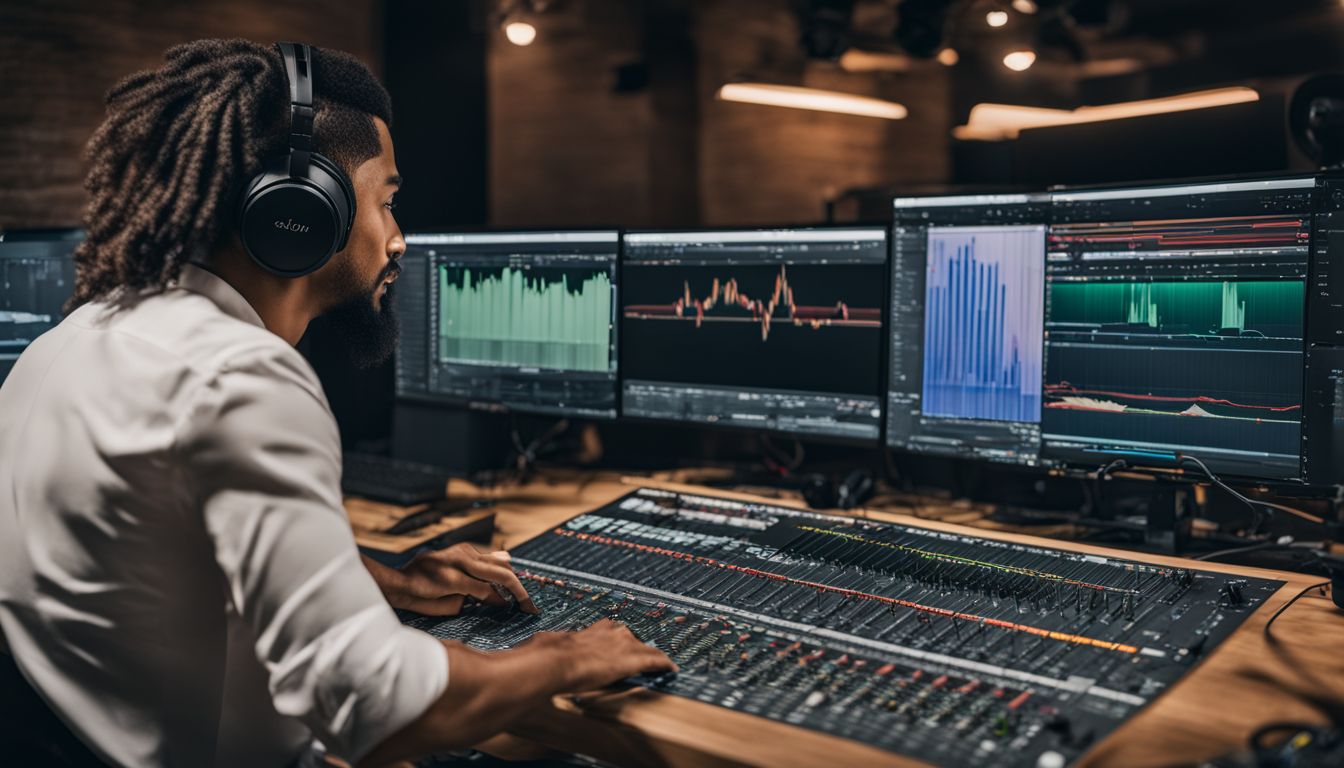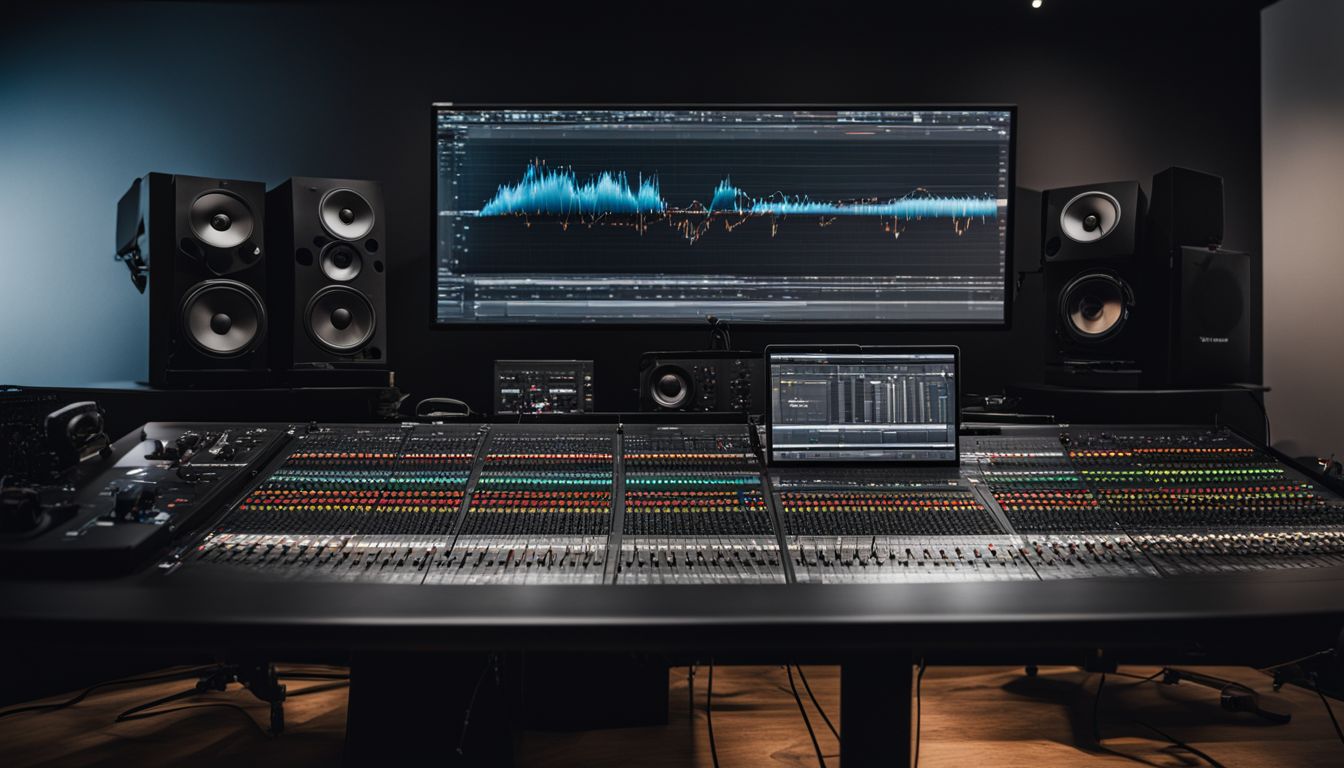Ever hit play on your playlist and had to scramble for the volume control as one song blares out much louder than the last? That’s a classic sign that those tracks weren’t normalized, a process that ensures audio levels are consistent.
This article will guide you through the process of understanding audio normalization. You can use this knowledge to enjoy seamless transitions between songs. You can also balance multi-track recordings effortlessly. Stick around; mastering this slice of sound tech is easier than you think!
Key Takeaways
- Audio normalization adjusts the volume of audio clips to a consistent level. It’s like setting a standard height to ensure everyone in a class photo can be seen.
- There are two main types of normalization. Peak normalization targets the loudest part of the sound to avoid distortion. Loudness normalization considers how humans perceive volume. It aims for uniformity across different listening environments.
- Normalization helps tracks stay at optimal levels for streaming services like Spotify and Apple Music. Each service has its own loudness standards, so using tools like LUFS meters is important during mastering.
- It’s useful for maintaining consistency among multiple audio files. However, audio normalization must be done carefully to prevent clipping and distortion. This means producers may need to adjust specific parts of an audio file before applying overall normalization.
- Any producer or engineer must understand the differences between audio normalizing and compressing. Normalization changes volume levels without altering the dynamic range. Compression reduces dynamic range by evening out loud and quiet sounds.
Understanding Audio Normalization
Audio normalization balances the volume of audio clips. It makes them play at a consistent level without having to adjust your speaker or headphone levels manually. It’s like setting a standard height for all students in a class photo; no one will stick out by being too tall or too short.
Engineers often use tools within digital audio workstations (DAWs). This ensures that every sound plays back at an optimal level and maintains the recording’s quality.
Peak normalization focuses on the highest amplitude point in an audio track. It adjusts this point to a target level, such as 0 dBFS—the maximum possible digital level without distortion. Loudness normalization uses measures like LUFS (loudness units relative to the full scale). These measures consider human perception. It evens out how we experience different sounds’ intensity.
This is why you can seamlessly enjoy your music playlist. You don’t have to reach for the volume control after each song or video clip ends. After understanding how normalization works, let’s delve into its importance across various listening platforms and scenarios.
Importance of Audio Normalization
Audio normalization is a vital step in ensuring your audio tracks playback at their best. It maintains both quality and consistency. It’s the unsung hero that can transform a good mix into a professional-sounding masterpiece, no matter where it’s played.
Preparation for Streaming Services
Preparing your tracks for streaming services is a must, considering each platform has its ideal loudness targets. Mastering engineers utilize tools like LUFS meters to measure the audio levels and adjust them accordingly.
This ensures that your music hits just the right volume on Spotify, Apple Music, or any other service. It prevents loss of quality and listener fatigue.
Normalization plays a big role in making sure every song stands out while maintaining a steady energy across an album or playlist. It’s all about hitting those specific loudness standards that different platforms expect.
Producers need to use this skill precisely. They must provide the best sound experience for listeners, no matter where they tune in.
Achieving Maximum Volume
Maximizing volume without sacrificing sound quality demands a masterful touch in audio normalization. Producers achieve this by adjusting the gain of an audio clip to its highest possible level without causing distortion. This allows for a powerful output that captures every nuance.
This process takes advantage of the full dynamic range available in digital systems. It especially helps with recordings that need to stand out or match levels across various tracks.
Loudness normalization is crucial. It ensures your track meets industry standards and delivers consistent playback on all platforms. This includes car stereos and club sound systems. Striking the perfect balance is about making the audio loud and clear. This ensures human hearing perceives the audio as rich and full-bodied.
Up next: creating a cohesive sound experience by leveling multiple files.
Creating Consistent Level Between Several Audio Files
Getting the maximum volume out of your audio tracks is just part of the puzzle. Another key aspect to consider is ensuring that your collection of audio files maintains a consistent level across the board.
This requires careful staging. It also requires applying uniform gain, which balances each track’s amplitude to a specified target level. Whether you’re mixing a podcast or blending different songs for an album, this step ensures every file hits the same volume sweet spot.
Utilizing tools like RMS volume detection and EBU R 128 volume detection helps achieve this balance. It does so by focusing on perceived loudness rather than just peak levels. RMS measures signal power over time. It provides a more accurate representation of how we perceive loudness in daily listening.
You can apply these techniques using sophisticated software or a digital audio workstation (DAW). This can create an even listening experience without jarring jumps in volume from one file to the next. It works for streaming platforms or CD-quality productions.
Different Types of Audio Normalization
We’ll uncover a variety of methods to enhance your soundscapes with audio normalization. Each method has its own unique approach. Stay tuned for the deep dive.
Peak Normalization
Peak normalization boosts your audio signal. It does not change the relationship between the loud and soft parts of your recording. Imagine turning up the volume knob until the loudest part hits just below the red zone on your meter. Keep everything clean and distortion-free.
The goal is to hit 0 dBFS, but it’s like a cliff—get too close, and you might slip into overloading territory.
Using peak normalization in an audio editor or DAW ensures that you’re squeezing out all possible volume from your track. It prevents any nasty clipping. It treats each track uniformly by lifting everything based on its highest point.
That’s perfect for making sure no single sound gets lost in a mix. It’s also great for ensuring everything matches up across different tracks. This is especially important when pulling together an album or playlist, where consistency is key.
Loudness Normalization
Loudness normalization is all about keeping the volume of audio consistent with our ears. This method doesn’t just look at the highest points of sound in your track; it focuses on how loud something feels to human hearing.
By measuring and adjusting audio levels to meet certain standards, like −14 LUFS for YouTube, listeners get a smooth experience. They won’t need to reach for the volume button every few minutes.
Incorporating loudness normalization into your audio editing process can help ensure that your songs or podcasts play well on different streaming platforms. They have their own loudness preferences.
It takes the Fletcher-Munson curve into account. This curve describes how we perceive different frequencies at various listening levels. It ensures what you hear is both clear and comfortable, no matter where it’s played.
But be mindful. Normalizing too much might push peaks beyond what digital systems can handle. This can cause distortion instead of harmony in your soundscape.
RMS Volume Detection
RMS volume detection dives into the technical side of audio normalization. It measures the consistent power of an audio signal over time. Peak normalization only looks at the highest level a signal reaches. RMS gives a more accurate picture of perceived loudness. It reflects how our ears process sound.
Producers and engineers use this method to ensure the average levels are where they want them. This provides a fuller listening experience without unwanted distortion.
In your Digital Audio Workstation (DAW), you might work with RMS to adjust volumes for different tracks effectively. This ensures that each element in your mix contributes equally to the overall energy of your recording.
Moving past RMS volume detection, other factors come into play when talking about loudness. Next, we’ll dissect how these elements influence what we hear in an audio file.
Factors That Affect Loudness in Audio Files
One primary factor impacting loudness is the signal-to-noise ratio. This measures the difference in volume between the audio you want to hear and background noise. A higher ratio means a clearer, louder sound because there’s less noise interfering.
The digital audio workstation (DAW) used during production also plays a crucial role. Each DAW has different features for adjusting levels, which can lead to varying loudness outcomes.
Another key element is the bit depth of an audio file. It determines the fineness of audio signal amplitude measurement. It affects dynamic range, the contrast between the softest and loudest sounds.
Using compressors or limiters changes the dynamic range. This makes sounds more uniform in volume, but it can reduce clarity if overused. Properly applied compression ensures that every note hits with consistent pressure and presence.
Audio effects like reverb or echo may also influence perceived loudness. They create a sense of space. Certain sounds might seem quieter than they are due to their position within that created ‘audio landscape’.
Understanding these factors helps ensure your tracks hit that sweet spot. They should be as immersive as intended without losing nuance or power on any playback system.
Audio Normalization vs. Compression
Audio normalization and compression are two techniques regularly used in audio processing. However, they serve different goals and affect sound differently. Here’s a breakdown of how they compare:
| Audio Normalization | Compression |
| Adjusts the volume to a target level without altering the dynamic range | Reduces the dynamic range by making loud sounds quieter and quiet sounds louder |
| Focuses on peak or loudness levels to achieve uniformity | Applies gain reduction to signals above a set threshold, altering the audio’s dynamics |
| Does not compress or expand the signal | Often uses ratios, thresholds, attack, and release settings to shape the sound |
| Enhances the listening experience by standardizing volume levels | It helps achieve a balanced mix that can prevent audio clipping and distortion |
| Commonly used to prepare files for streaming services where consistent volume is desired | Widely used in music production to glue tracks together and create a fuller sound |
| May result in audio with less impact if not carefully applied | Can lead to over-compression, resulting in a ‘squashed’ sound lacking dynamic interest |
Producers and audio engineers must understand the difference between audio normalization and compression. It is essential for delivering polished, professional audio content. Understanding and utilizing these processes effectively can profoundly affect the final audio experience. This is true for streaming and dynamic musical compositions.
Downsides of Audio Normalization
Audio normalization may seem like a fix-all for varying volume levels, but it has its pitfalls. One major downside is its potential to distort clipping. Clipping happens when the audio signal exceeds the maximum level that a system can handle. This leads to unpleasant audio artifacts and a loss of clarity.
This typically occurs if an unmastered track has a high dynamic range. It happens when normalization occurs without proper peak amplitude adjustment.
Another challenge posed by normalization involves inconsistencies across different platforms. This is due to varying loudness standards. For example, the LUFS standard used by streaming services might not align with the DBFS levels considered in broadcasting. This could cause differences in perceived loudness between platforms.
As a result, your meticulously normalized track could sound perfect on one system but too quiet or overly loud on another. Some DAWs also provide features like replay gain or automatic dynamic range compression. These features prevent clipping during normalization. However, these processes are inherently destructive. They permanently alter the original waveform and limit what you can do in the post-production editing stages.
How to Normalize Audio
To normalize audio effectively, you need a systematic approach that caters to your specific audio files. Here’s a straightforward guide to help you get it right.
- Choose the appropriate software for the task. For example, Audacity and Ableton Live both support various normalization techniques.
- Import your audio file into the digital audio workstation (DAW) of your choice; this is where you’ll make all adjustments.
- Determine the type of normalization required for your project – peak or loudness – based on your target platform and content type.
- Set your desired target level, such as -1 dBFS for peak normalization or -23 LUFS for broadcast standards like EBU R128.
- Identify and mark any potential problem areas in the waveform. Clipping might occur during normalization.
- If necessary, apply clip gain to specific sections. Make sure they don’t exceed your chosen target level in subsequent steps.
- Use the normalization feature in your DAW to bring up the overall signal level uniformly across all samples.
- After normalizing, scan the entire track to confirm there are no distorted peaks from excessive gain.
- If peaks are present post-normalization, gently utilize audio compression to tame them. Avoid sacrificing dynamic range too much.
Conclusion
Now that you’ve got the lowdown on audio normalization, your tracks are ready to hit a consistent mark. Dive into your DAW and tweak those faders; achieve that perfect sound level without distortion.
Remember, the right balance in loudness makes all the difference for your listeners’ experience. Normalize wisely, and let every beat drop at just the right volume. Keep this guide handy; it’s your ticket to mastering audio files like a pro!
If you’re interested in further exploring what factors contribute to the loudness of speakers, be sure to read our detailed guide here.
FAQs
What is audio normalization?
Audio normalization adjusts an audio recording to a standard loudness level. It ensures all sounds are consistent and clear.
Why do we use LUFS in audio normalization?
LUFS, or Loudness Units Full Scale, measures the perceived loudness of the audio. It helps achieve a uniform volume across different recordings. This is especially important for digital streaming.
Can RMS levels affect how we perceive sound?
Yes, Root Mean Square (RMS) levels represent the average power of audio signals. This measure can greatly influence our perception of sound’s loudness due to the Fletcher Munson Curve.
Is it true that louder music always sounds better because of the ‘loudness war’?
Contrary to common beliefs about the ‘loudness war’, excessively boosting volume can reduce sound quality. Balance and clarity are key.
Should I only normalize my audio if using digital equipment like DAWs (Digital Audio Workstations)?
Normalization is useful across both analog and digital platforms. However, tools like Digital Audio Workstations make it easier to adjust dBFS, which stands for decibels relative to full scale. This is for optimal sound quality on any device.


